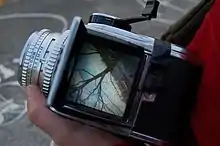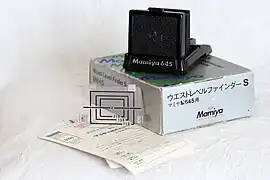

The waist-level finder (WLF), also called waist-level viewfinder (WLVF), is a type of viewfinder that can be used on twin lens and single lens reflex cameras. While it is typically found on older medium format cameras, some newer and/or 35 mm cameras have this type of finder (perhaps as an option).
In the reflex camera, the light from the lens is projected onto a focusing screen. The waist-level finder makes this screen viewable from above, where the image is seen upright but reversed left-to-right. This allows the camera user to determine the target area while holding the camera below eye level.[1]
The eye-level finder is an evolution of the waist-level finder, using a roof pentaprism or pentamirror to correct the image while making it viewable through an eyepiece at the rear of the camera.
Some digital cameras have an articulating screen or a swivel lens, this allows the screen to be angled to make it viewable at waist-level. With live preview the screen can be used as a viewfinder.
Advantages
- The photographer is looking down into the camera, attracting less attention compared to an eye-level finder. This makes it better for street or candid photography.
- Even when they know they are being photographed, the subject may feel less "targeted" because the photographer is not looking at them.
- The camera is often held against the belly or resting on something (e.g. table, the lap, etc.), resulting in less motion blur.
Disadvantages
- The image is reversed left-to-right, making it tricky to follow moving subjects.
See also
- Articulating screen — similar functionality for digital cameras
References
- ↑ Scientific American. Munn & Company. 1932. p. 57.